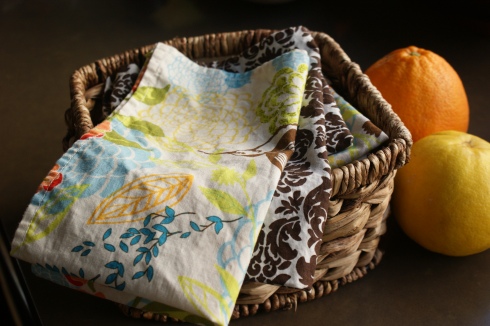You are currently browsing the monthly archive for March 2011.
Growing up, my mom would make ox tail soup regularly in the winter. While I liked the soup enough, the ox tail itself was not that memorable. There was a little bit of meat and lots of bone. It was a good way to make flavorful broth for not a lot of money. Fast forward a few years and I have rediscovered the ox tail. Except now I enjoy it as a stew that can be made in either the oven or on the stove. Like the pulled pork or brisket recipes, this one requires a longer cooking time but it’s very much worth it in the end. The ox tail I get is pretty meaty and also fairly fatty and I would definitely recommend trimming the fat before cooking. While I typically like keeping some fat, having too much of it just makes the whole dish oily.
Braised Ox Tail
Serves 6
4 pounds grass-fed ox tail, cut into 2-inch sections
1/2 to 3/4 cup red wine
2 to 3 tablespoons Trader Joe’s 21 Seasoning Salute
2 tablespoons tomato paste
4 – 6 roma tomatoes, chopped
2 medium onions, chopped
4 carrots, chopped
4 to 5 ribs celery, chopped
3 cloves garlic, chopped
1 cup frozen peas
2 teaspoons himalayan salt
1 teaspoon ground black pepper
1 bay leaf
Rinse and pat dry ox tail pieces. Trim fat if necessary. Sprinkle ox tail with a couple pinches of salt and a pinch of black pepper.
Oven
- Set oven to broil and place ox tail on roasting pan or baking dish.
- Broil ox tail for 5 – 6 minutes. Turn pieces over and broil another 5 to 6 minutes, until exterior looks crispy and brown.
- Remove from oven and transfer to plate. Drain excess fat from pan or dish.
- Turn oven down to 375 degrees F.
- Mix tomato paste, red wine, salt and pepper and set aside.
- Place tomatoes, onions, carrots, celery, garlic and bay leaf on the bottom of the pan or dish then add the browned ox tail.
- Sprinkle the 21 Seasoning Salute ( or your favorite mix of herbs) over the meat and pour the wine mixture over everything.
- Roast covered for 2 1/2 hours.
- Uncover and stir in peas. Cook for another 30 minutes.
Stove top
- Heat cast-iron dutch oven over medium heat with 1 tablespoon coconut oil or grapseed oil.
- Place ox tail in dutch oven to brown and sear for about 5 minutes.
- When meat releases from oven bottom easily, turn over and sear another 4-5 minutes.
- Add onions, carrots, and celery and cook for a few minutes until vegetables begin to soften.
- Deglaze pot with red wine and add remaining ingredients, except peas, to pot and cover pot.
- Cook for 2 1/2 to 3 hours on the stove over low heat. Check periodically and add 1/2 cup water or beef stock at a time if mixture looks dry.
- Ox tail is done when the meat separates easily from the bone with a fork.
- Add peas and cook for another 5 to 10 minutes.
- Remove bay leaf and serve.
If you’re looking for an ox tail recipe with Asian flavor, check out Sunday Nite Dinner. There are any number of ways to cook ox tail and they all end with a hearty and satisfying meal.
You’ve probably figured out from the title and photo that this post is not going to be about food. It’s not. But the idea was worthwhile enough that I want to share. I was reading about the Johnson family of The Zero Waste Home and was spurned to act. Yes, we recycle and, yes, we compost, but what my family consumes and throws away is quite shameful when I see what the Johnsons have done. (Case in point, it’s Sunday and our recycle bin is already full and the next pickup isn’t until Friday!) So I decided on the spot that I would start with something small and keep working at it. I came up with replacing our paper napkins with cloth ones. We have been cloth diapering our almost-2-year old since she was born and it stands to reason that if we could do that, the napkin switch should be a piece of cake (and much less stinky). It also seems to be in line with the whole primal way of living. Eating whole, natural foods means going back to the basics. The ingredients require little packaging and, with some creativity, can be used almost entirely without much waste. Shouldn’t the rest of the household dealings follow suit? I’d say so.
Having decided to go with reusable napkins, the next decision was whether to buy them or make them myself. I went with the cheaper option of making them. Now, I’m not the craftiest person – I don’t scrap book and I don’t make my own baby clothes. I do own a sewing machine, though, and know enough of the basic functions to operate it safely. So I bought some pretty, 100% cotton fabric that was on sale and settled in for a DIY weekend. I had no template or pattern, I just folded the fabric over on itself enough times to get a size I wanted and cut to size. Then I pressed and hemmed the edges and threw them in the wash. What you see is what came out of the dryer and folded. They’re a bit wrinkly but perfectly fine for casual dining. Once used, I store them in a little container under the sink and I’ll wash them once a week with the kitchen towels. For 3 yards of fabric, I got 24 cute napkins and the freedom from buying a gargantuan package of disposable napkins at Costco. That’s a pretty good trade off to me.




